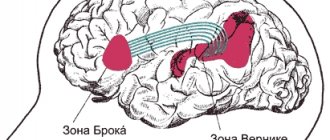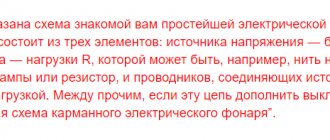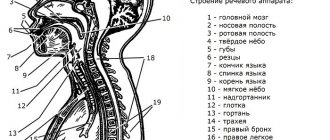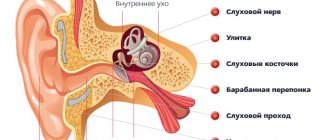The emergence of speech in humans and the formation of sounds is possible thanks to the speech apparatus. The speech apparatus is a set of coordinated organs that help form the voice, regulate it and form it into meaningful expressions. Thus, the human speech apparatus includes all elements directly involved in the creation of sounds - the articulatory apparatus, including the central nervous system, respiratory organs - lungs and bronchi, throat and larynx, oral and nasal cavities.
The structure of the speech apparatus
The structure of the human speech apparatus, that is, its structure, is divided into two sections - the central and peripheral sections. The central link is the human brain with its synapses and nerves. The central speech apparatus also includes the higher parts of the central nervous system. The peripheral department, also known as the executive department, is a whole community of elements of the body that ensure the formation of voice and speech. Further, according to the structure, the peripheral part of the speech apparatus is divided into three subsections:
- The department that regulates respiratory processes. Breathing is an important function of the body. It is implemented by special nerve centers and occurs automatically. Sounds from the body always come out during exhalation, and the air wave formed at this moment helps to perform two tasks at once - articulatory function and voice formation. This section includes the lungs and bronchi, the muscles located between the ribs, and the diaphragm.
- Voice department. The voice has three characteristics. This is its power, timbre and height. The work of the vocal cords causes vibrations in the air, transmitted to the outside world, perceived as voice.
- The articulatory apparatus is the department that directly forms sounds into speech. Consists of active and passive organs. Active organs of articulation are movable, helping to form sounds. The main organs of articulation are the lips and tongue, palate and jaw. Their changes in position lead to the creation of narrowings in different places of the articulation department. The character of the sound produced depends on this position. The mandible helps create stressed vowels. The tongue is the main muscle of the articulatory apparatus. The clarity of pronounced sounds depends on its ability to be flexible and transformative. The lips are also a moving part and contribute to the formation of vowel sounds and speech, they are an important organ in the articulation of words, which is helped by the specific placement of the tongue.
Passive organs included in the articulatory apparatus are immobile organs. Their main task is to be the foundation, the basis for active organs. Passive organs include teeth and the entire oral cavity, and the hard palate. As well as the pharynx and larynx. Although they are motionless, they still influence, albeit slightly, the speech potential and character of a person’s speech.
Voice formation
In every language on our planet there is a specific number of sounds that create the acoustic image of the language. The sound finds meaning only in the scheme of sentences and helps to distinguish one letters from others. This sound is called a phoneme of the language. All sounds of a language differ in articulatory characteristics, that is, their difference comes from the formation of sounds in the human speech apparatus. And by acoustic characteristics - by differences in sound.
The voice can be considered the result of the hard work of the muscles of various components of the peripheral speech apparatus. Three of its departments contribute to the formation of sound:
- respiratory, otherwise energetic - includes the lungs, bronchi, trachea and throat;
- voice-forming department, otherwise generator - the larynx along with sound cords and muscles;
- sound-producing, otherwise resonator - the cavity of the oropharynx and nose.
The work of these departments of the speech apparatus in complete symbiosis can only occur through the central control of speech and voice-forming processes. This suggests that the respiratory process, articulatory mechanism and sound formation are completely controlled by the human nervous system. Its impact also extends to peripheral processes:
- the functioning of the respiratory organs regulates the power of the voice;
- the functioning of the oral cavity is responsible for the formation of vowels and consonants and for the difference in the articulatory process during their formation;
- The nose section provides adjustment of the overtones of the sound.
The central speech apparatus occupies a key place in the formation of the voice. The human jaw and lips, palate and supraglottic lobe, pharynx and lungs are all involved in the process. The air flow leaving the body, going further through the larynx and passing through the mouth and nose is the source of sound. On its way, the air passes through the vocal cords. If they are relaxed, then the sound is not formed and passes freely. If they are close and tense, the air creates vibration as it passes. The result of this process is sound. And then, with the work of the movable organs of the oral cavity, the direct formation of letters and words occurs.
Lecture 2 phonetics. Aspects of considering speech sounds. Phonetic division of speech.
Plan
- Phonetics: definition, subject, object.
- Acoustic aspect of phonetics.
- The structure of the speech apparatus, articulation.
- Classification of speech sounds.
- Syllable and syllable division.
- Prosodic means of language.
1. Phonetics
is a branch of linguistics that studies the sound side of language. It includes all the sound means of the language, that is, not only sounds and their combinations, but also stress and intonation.
Depending on the volume of material that is the subject of direct research by phoneticians, general phonetics,
comparative phonetics
and
private phonetics
of individual languages are distinguished.
General phonetics
examines the patterns characteristic of the sound side of any language.
Comparative phonetics
deals with identifying the common and special in the sound aspect of two or more comparable or compared languages.
Phonetics of individual languages
studies the features of the sound side of an individual language as fully as possible.
In turn, in the phonetics of individual languages, historical phonetics and
descriptive
Historical phonetics of a particular language studies the history of the sound means of a given language to the extent that it is reflected in written records in this language, dialect speech, etc. Descriptive phonetics studies the sound means of a particular language at a certain period of its history or in its present state.
In phonetics, such particular disciplines as acoustic phonetics are distinguished; articulatory phonetics; perceptual phonetics; functional phonetics, or phonology; accentology, or the study of verbal stress; intonology, or the study of intonation:
- acoustic
phonetics studies the purely physical features (characteristics, parameters) of speech sounds of individual languages;
- articulatory
phonetics studies the activity of the human speech apparatus, the physiology of speech, as a result of which sounds are produced;
- perceptual
phonetics examines the peculiarities of perception of speech sounds by the human hearing organ;
- functional
phonetics, or
phonology ,
studies the functions that speech sounds perform as part of the sounds that form the material, perceptual side of the meaningful units of language: morphemes, words and their forms.
Among other linguistic units - grammar, lexicology - phonetics occupies an equal position with them as an independent science. It interacts primarily with grammar. This interaction is due to the fact that the same sound features of the sound form of linguistic phenomena turn out to be significant not only for the sound side of the language, but also for some areas of its grammatical structure. For example, certain types of alternations turn out to be morphologized, that is, they are used in the formation of different forms of the same words or different words from the same root morphemes (cf. in Russian: wake up - buzhu, drive - drive, friend - friend
or in German:
sprechen - sprach , stechen - stach
).
2. Acoustic aspect of phonetics.
The section of phonetics
“speech acoustics”
studies the physical characteristics of speech.
Speech sounds
- These are vibrations in the air caused by the organs of speech. Sounds are divided into tones (musical sounds) and noises (non-musical sounds).
Tone
- These are periodic (rhythmic) vibrations of the vocal cords.
Noise
– these are non-periodic (non-rhythmic) vibrations of a sounding body, for example, lips.
Vowels consist of tone, i.e. voices in the absence of an obstacle, and consonants made of noise (or noise and tone), i.e. involving an obstacle.
Speech sounds vary in pitch, strength and duration.
Pitch
is the number of oscillations per second (hertz). It depends on the length and tension of the vocal cords. Higher sounds have a shorter wavelength. A person can perceive the frequency of vibrations, i.e. pitch in the range from 16 to 20,000 hertz. One hertz is one vibration per second. Sounds below this range (infrasounds) and above this range (ultrasounds) are not perceived by humans, unlike many animals (cats and dogs perceive up to 40,000 Hz and higher, and bats even up to 90,000 Hz).
The main frequencies of human communication are usually in the range of 500–4000 Hz. The vocal cords produce sounds from 40 to 1700 Hz. For example, bass usually starts at 80 Hz, and soprano is defined at 1300 Hz. The natural frequency of vibration of the eardrum is 1000 Hz. Therefore, the most pleasant sounds for humans - the sound of the sea, the forest - have a frequency of about 1000 Hz.
The range of vibrations of the sounds of a man's speech is 100 - 200 Hz, in contrast to women, who speak with a frequency of 150 - 300 Hz (since men's vocal cords are on average 23 mm, and women's are 18 mm, and the longer the cords, the lower the tone) .
The strength of sound (loudness) depends on the wavelength, i.e. on the amplitude of oscillations (the amount of deviation from the original position). The amplitude of vibrations is created by the pressure of the air stream and the surface of the sounding body.
The strength of sound is measured in decibels. Whisper is defined as 20 - 30 dB, normal speech - from 40 to 60 dB, the volume of a scream reaches 80 - 90 dB. Singers can sing at up to 110–130 dB. The Guinness Book of World Records records a record for a fourteen-year-old girl who screamed over a taking off airliner with an engine volume of 125 dB. When the sound intensity exceeds 130 dB, ear pain begins.
Different speech sounds have different strengths. The sound power depends on the resonator (resonator cavity). The smaller its volume, the greater the power. But, for example, in the word “saw” the vowel [i], being unstressed and generally having less power, sounds several decibels stronger than the stressed [a]. The fact is that higher sounds seem louder, and the sound [i] is higher than [a]. Thus, sounds of the same strength but different pitches are perceived as sounds of different volumes. It should be noted that sound intensity and loudness are not equivalent, since loudness is the perception of sound intensity by a person's hearing aid. Its unit of measurement is background,
equal to a decibel.
Sound duration
(oscillation time) is measured in milliseconds.
Sound has a complex composition. It consists of a fundamental tone and overtones (resonator tones).
Base tone
is a tone generated by vibrations of the entire physical body.
Overtone
- a partial tone generated by vibrations of parts (half, quarter, eighth, etc.) of this body. The overtone (“upper tone”) is always a multiple of the fundamental tone, hence its name. For example, if the fundamental tone is 30 Hz, then the first overtone will be 60, the second 90, the third 120 Hz, etc. It is caused by resonance, i.e. the sound of a body when it perceives a sound wave having a frequency that is the same as the frequency of vibration of this body. The overtones are usually weak, but are amplified by resonators. Speech intonation is created by changing the frequency of the fundamental tone, and timbre is created by changing the frequency of overtones.
Timbre
- This is a kind of coloring of sound created by overtones. It depends on the relationship between the fundamental tone and overtones. Timbre allows you to distinguish one sound from another, distinguish the sounds of different faces, male or female speech. Each person's timbre is strictly individual and unique, like a fingerprint. Sometimes this fact is used in forensic science.
Formanta
is an overtone amplified by a resonator that characterizes a given sound. Unlike the vocal tone, the formant is not formed in the larynx, but in the resonating cavity. Therefore, it persists even when whispering. In other words, this is the band of concentration of sound frequencies that receives the greatest amplification due to the influence of resonators. With the help of formants we can quantitatively distinguish one sound from another. This role is played by speech formants - the most important in the spectrum of a vowel sound are the first two formants, which are closest in frequency to the fundamental tone. Moreover, each person’s voice is characterized by its own voice formants. They are always higher than the first two formants.
The formant characteristics of consonants are very complex and difficult to determine, but vowels can be characterized with some reliability using the first two formants, which correspond approximately to articulatory features (the first formant is the degree of tongue elevation, and the second is the degree of tongue advancement). It should only be borne in mind that the quantitative data presented are approximate, even conditional, since researchers give different data, but the vowel ratios, despite the discrepancy in numbers, remain approximately the same for everyone, i.e. the first formant, for example, of the vowel [i], will always be smaller than that of [a], and the second is larger.
The frequency characteristics of sounds are flexible, since the formants are correlated with the lowest fundamental tone, and it is also changeable. In addition, in live speech, each sound may have several formant characteristics, since the beginning of a sound may differ from the middle and ending in formants. It is very difficult for a listener to identify sounds isolated from a stream of speech.
3. The structure of the speech apparatus.
The branch of phonetics that studies the structure of the speech apparatus is called
anthropophonics,
or
the physiology of speech.
She studies the biological characteristics of speech, i.e. the work performed by a person when pronouncing (articulating) or perceiving speech sounds.
The structure of the human speech apparatus.
When communicating using language, a person pronounces sounds and perceives them. For these purposes, he uses the speech apparatus - a set of organs of the human body adapted for the production and perception of speech. The speech apparatus in a broad sense covers:
- central nervous system,
- organs of hearing and vision,
- speech organs.
The central nervous system is represented by the brain, which, through the motor speech center (Broca's area), sends certain impulses through the nervous system to the organs of speech production (articulation).
The speech organs, or speech apparatus in the narrow sense, include:
• breathing apparatus (lungs, bronchi, trachea, diaphragm and chest), which creates an air stream that provides the formation of sound vibrations necessary for articulation;
• organs of pronunciation (articulation) of speech, which are usually also called organs of speech (in the narrow sense).
According to their role in pronouncing sounds, the speech organs are divided into active and passive;
— active
the organs of speech produce certain movements necessary for the formation of sounds, and are thus particularly important for their formation. The active organs of speech include the vocal cords, tongue, lips, soft palate, uvula, posterior dorsum of the pharynx (pharynx) and the entire lower jaw;
— passive
the organs do not perform independent work during sound production and perform only an auxiliary role. The passive organs of speech include the teeth, alveoli, hard palate and the entire upper jaw.
Vocal cords
are located in the larynx. The larynx is the upper part of the trachea and consists of the following three types of cartilage connected to each other:
- cricoid cartilage,
located below other cartilages. It is narrower in front and wider in back;
- thyroid cartilage,
located at the top in front (in men it acts like an Adam’s apple, or Adam’s apple, because the two plates forming it make an angle of 90 degrees, and in women - 110 degrees), covers the cricoid cartilage in front and on the sides;
- paired arytenoid cartilage
in the form of two triangles located at the back from above. They can move apart and move.
Between the arytenoid and thyroid cartilage there are mucous folds, which are called the vocal cords.
They converge and diverge with the help of arytenoid cartilages, forming a glottis of various shapes.
• During non-speech breathing and when pronouncing dull sounds, they are spread apart and relaxed. The gap has the shape of a triangle.
- When pronouncing vowels, sonorants, and voiced consonants, they first tense and come together, and then move apart and move, allowing a push of air to pass through. At the same time they vibrate.
- When pronouncing English or German [h] and some guttural sounds (for example, in Arabic), as well as when whispering, they are close together, but relaxed, and air passes through them with difficulty. The vocal cords do not vibrate.
In men, as mentioned above, the vocal cords are longer (23 mm on average) and thicker than in women (18 mm).
A person speaks as he exhales, while he inhales only the donkeys shout: “ya.” Inhalation is also used when yawning.
People with a larynx amputation are also able to speak with a so-called esophageal voice, using muscle folds in the esophagus as a larynx.
For the formation of sound, the oral (epiglottic) cavity is of great importance, in which noises and resonator tones are formed, which are important for creating timbre. The size and shape of the mouth and nose play a big role.
The tongue is a mobile organ that performs two speech functions: 1) depending on its position, it changes the shape and volume of the resonator; 2) creates obstacles when pronouncing consonants.
The lips and tongue also serve as a barrier.
The soft palate in an elevated position blocks the entrance to the nasal cavity, and sounds will not have a nasal overtone. If the soft palate is lowered, then the air stream passes freely through the nose and as a result, nasal resonance occurs, characteristic of nasal vowels and sonants.
Russian and Latin names of speech organs and their derivatives
| Language | lingua | linguistic |
| Lips | labia | labial, labialized |
| Teeth | clentes | dental |
| Alveoli | alveoli (grooves) | alveolar |
| Solid sky | palatum | palatal |
| Soft sky | velum (sail) | velar |
| Tongue | uvula (grape) | uvular |
| Nose | nasus | nasal |
| Pharynx (pharynx) | pharynx | pharyngeal |
| Larynx | larynx | laryngeal |
Articulation of speech sound.
Articulation of speech sounds
- this is the work of the speech organs necessary to pronounce sound. To form each speech sound, a complex of work of the speech organs is required in a certain sequence, that is, a very specific articulation is needed.
The articulation of the sound of speech consists of a set of movements and states of the speech organs - the articulatory complex; therefore, the articulatory characteristic of speech sound turns out to be multidimensional, covering from 3 to 12 different features.
The complexity of sound articulation also lies in the fact that it is a process in which three phases of sound articulation are distinguished:
- attack (excursion)
consists in the fact that the organs of speech move from a calm state to the position necessary to pronounce a given sound;
- excerpt
- this is maintaining the position necessary to pronounce a sound;
- indentation (recursion)
– articulation consists of transferring the speech organs to a calm state.
4. Classification of speech sounds
is based on the acoustic and anatomical-physiological characteristics of sounds.
Each language typically contains about 50 speech sounds.
1) From an acoustic point of view, they are divided into vowels,
consisting of tone, and
consonants
formed by noise (or noise + tone). When pronouncing vowels, air passes freely, without obstacles, and when articulating consonants, there is always some kind of obstacle and a certain place of formation - the focus.
During the formation of vowels, the voice prevails over noise, while during the formation of most consonants (with the exception of sonorants), the relationship is the opposite: noise dominates over the voice. The presence of two types of speech sounds (vowels and consonants), differing in articulation, forces a classification of vowels to be made separately from the classification of consonants.
As their name suggests, vowels are formed with the help of the voice, i.e. they are always sonorous (from the Latin sonus
- sound).
2) The articulatory difference between vowels and consonants consists of different tensions of the pronunciation apparatus and the absence or presence of a focus of formation.
3) But the main difference between vowels and consonants is their role in syllable formation. A vowel sound always forms the top of a syllable and is a sonant; a consonant accompanies a sonant and is a consonant.
Vowel cluster
in the language it is called
vocalism,
and
the set of consonants is called consonantism.
Vowel classification
Vowels are classified according to the following main articulatory features:
1) row,
those.
depending on which part of the tongue is raised during pronunciation: when the front part of the tongue is raised, front vowels
are formed (
i, e
), middle -
middle
(
s
), back -
back
vowels (
o, y
);
2) climb
, i.e.
depending on how high the back of the tongue is raised, forming resonator cavities of varying volumes; there are differences between open
or
wide
a
)
and closed
that
narrow
i
y )
(in some languages, for example, in German and French, sounds that are close in articulation differ only in small difference in the rise of the tongue. Compare open [b] in the words
derm
(German);
fait , pret
(French); and closed [e] in the words
Meeg
(German);
fee , pre
(French));
3) labialization
– participation of the lips in the articulation of sound: depending on whether the articulation of sounds is accompanied by rounding of the lips extended forward or not, rounded (labial, labialized) are distinguished, for example. [o], [u] and unrounded vowels, e.g. [A];
4) nasalization
– the presence of a special “nasal” timbre that occurs depending on whether the velum is lowered, allowing a stream of air to pass simultaneously through the mouth and nose, or not. Nasal (nasalized) vowels, for example, are pronounced with a special “nasal” timbre. Vowels in most languages are non-nasal (formed when the palatine curtain is raised, blocking the path of air flow through the nose), but in some languages (French, Polish, Portuguese, Old Church Slavonic), nasal vowels are widely used along with non-nasal vowels;
5) longitude:
in a number of languages (English, German, Latin, Ancient Greek, Czech, Hungarian, Finnish), with the same or similar articulation, vowels form pairs, the members of which are contrasted in duration of pronunciation, i.e.
they differ, for example, short vowels: , , [o], [i] and long vowels: [a:], [i:], [o:], [i:].
In Latin and ancient Greek, this phenomenon is used in versification: various poetic meters (hexameter, dactyl) are based on the ratio of long and short syllables, which correspond to modern poetic meters, which are based on dynamic stress.
| Climb | Row | |
| Front | Rear | |
| Unrounded | Gulped | |
| Upper | and, s | at |
| Average | e | O |
| Lower | A | |
Structural components of speech
Responsible for speech function:
- The sensory speech center is the perception of speech sounds, based on the sound discrimination system of the language; Wernicke's area in the left hemisphere of the brain is responsible for this process.
- The center of motor speech - Broca's area is responsible for it, thanks to it it is possible to reproduce sounds, words and phrases.
In this regard, in clinical psychology there is the concept of impressive speech, in other words, the understanding and presentation of oral and written speech. There is also the concept of expressive speech - that which is spoken out loud accompanied by a certain tempo, rhythm, and emotions.
In the process of speech formation, each person should have a clear understanding of the following subsystems of their native language:
- phonetics (what syllables, sound combinations can be, their correct structure and combination);
- syntax (understanding exactly how the relationships and combinations between words occur);
- vocabulary (knowledge of the vocabulary of the language)
- semantics (the ability to understand the meaning of words long before acquiring pronunciation skills);
- pragmatics (relationships between sign systems and those who use them).
The phonological component of a language means knowledge of the semantic units of the language (phonemes). Physically, speech sounds can be divided into noises (consonants) and tones (vowels). Any language is based on a certain distinctive feature; if you change one of them, the meaning of the word will change dramatically. The main semantic distinguishing features include deafness and sonority, softness and hardness, as well as stress and unstress. It is these features that act as the basis of the phonemes of the language system. Each language has a different number of semantic units, usually from 11 to 141.
The Russian language involves the use of 42 phonemes, in particular, 6 vowels and 36 consonants.
It has been scientifically proven that any healthy infant in the first year of life has the ability to reproduce 75 different shortest sound units, in other words, can learn any language. But, most often, children at the initial stages of their development are in only one language environment, so over time they lose the ability to reproduce sounds that do not belong to their native Russian language.
Sound structure of the Russian language
Russian writing is sound, or more precisely, phonemic (phonemic). This means that each basic sound of speech, or each phoneme, in the graphic system of the language has its own sign - its own grapheme.
The methodology for teaching literacy, focusing students and teachers on sounds, takes into account the features of the Russian phonetic system.
It is very important for teaching literacy which sound units in the Russian language perform a meaningful function (i.e., they are phonemes, “basic sounds”), and which do not perform such a function (variants of “basic sounds” are phonemes in weak positions).
There are 6 vowel phonemes in the Russian language: a, o, u, s, i, e - and 37 consonant phonemes: hard p, b, m, f, v, t, d, s, z, l, n, sh, zh , r, g, k, x, c, soft p', b', m', f', e', ig', d', s', z', l', n', p', long w ' , long w', h, and . The phonemes g, k, x appear in their soft versions only before the vowels e, i. Strong positions for vowel phonemes are under stress, strong positions for consonant phonemes (except and) are located before the vowels a, o, y, and (for paired voiced-voiceless and hard-softness there are additional cases, which are outlined in the textbook "Modern Russian language"). The phoneme also stands before stressed vowels “In a strong position, in other cases it appears in a weak position (the so-called non-syllabic and: my - mine).
In weak positions, phonemes appear as variants that do not sound distinct enough (water - o? a?) or turn into the opposite pair (frost - at the end with). It is not difficult to see that there are a lot of phonemes appearing in weak positions, that is, sounding unclear, indistinct, in speech, and this cannot but be taken into account in teaching literacy.
Important:
According to the St. Petersburg Phonological School, there are 43 phonemes in the Russian language: [a e i o y y p' b b' m m' f f' v v' t t' d d' n n' s s' z z' r r ' l l ' w w ? ts h y k k' g g' x x']. Sometimes [?] (voiced equivalent [ш]) is not isolated as a separate phoneme, since it has practically fallen out of use in literary Russian; in this case, 42 phonemes remain.
The Moscow phonological school does not distinguish the phoneme [s], considering it equal to the phoneme [i]; Also, hard and soft variants of the phonemes [k], [g] and [x] do not differ. In this case, there are 39 phonemes.








